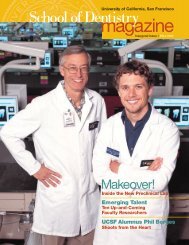Acknowledgements - UCSF School of Dentistry - University of ...
Acknowledgements - UCSF School of Dentistry - University of ...
Acknowledgements - UCSF School of Dentistry - University of ...
Create successful ePaper yourself
Turn your PDF publications into a flip-book with our unique Google optimized e-Paper software.
in treating such defects, but the mechanisms are not well understood. Recently, we identified that 45S5 bioglass enhanced collagen<br />
type I and osteocalcin expression in hPDLFs. Several ions were identified as being released by the bioglass, with Silicon ion being<br />
most prominent.<br />
Objectives: The purpose <strong>of</strong> this study was to determine the effects <strong>of</strong> silicon ion on hPDLFs, in comparison to whole extracts <strong>of</strong><br />
45S5 Bioglass.<br />
Methods: Glass conditioned medium (GCM) was prepared by soaking 45S5 glass powders in DMEM for 3 days to make 45S5 ion<br />
extracts. Silicon medium was prepared by dissolving sodium metasillicate in DMEM. All media was sterile-filtered and supplemented<br />
with 10% FBS, 1% pen-strep, and 1% fungizone. Human periodontal ligament fibroblasts were cultured in either control media,<br />
silicon media, or GCM, and the medium was changed every 2 days for up to 16 days. All experiments were carried out in triplicate.<br />
At days 2, 4, 8 and 16, cultures were stopped and submitted for gene analysis. At day 16, cultures were also submitted for protein<br />
analysis.<br />
Results/ Conclusions: The results <strong>of</strong> this work are currently in progress, and may provide new tools for understanding how silicon<br />
ions regulate osteogenesis.<br />
Support: American Association <strong>of</strong> Dental Research (AADR) Student Research Fellowship and The Department <strong>of</strong> Or<strong>of</strong>acial<br />
Sciences<br />
II. GRADUATE CATEGORY<br />
#29 Title: Odontoblasts <strong>of</strong> Immature Rat Molars Lack Expression <strong>of</strong> TRPV1<br />
J J EMRICK (1) and D J JULIUS (2)<br />
(1) <strong>UCSF</strong> Department <strong>of</strong> Preventive and Restorative Dental Sciences, (2) Department <strong>of</strong> Physiology<br />
Introduction:Thermal changes in the oral cavity are a common trigger <strong>of</strong> dental pain (Pashley, 1996). Members <strong>of</strong> the transient<br />
receptor potential (TRP) family <strong>of</strong> ion channels are responsible for initiating the cellular mechanisms <strong>of</strong> thermal sensation and<br />
nociception. Specifically, TRPV1 is responsible for detecting noxious heat (Caterina et al., 1997), and is functionally expressed in<br />
mouse and human odontoblasts (Son et al., 2009; El Karim et al., 2010). Recent evidence in adult rats suggests that TRPV1<br />
expression in odontoblasts may be limited to immature teeth without fused apices (Yeon et al., 2009).<br />
Objective: We studied rat odontoblast expression <strong>of</strong> TRPV1 in molars prior to maturation <strong>of</strong> the apices using micr<strong>of</strong>luorometry.<br />
Methods: Odontoblasts were prepared as previously described in Guo, et al., 1999. Briefly, maxillary and mandibular first and<br />
second molars were extracted from 4 week old Sprague-Dawley rats following CO2 euthanasia and cervical dislocation. Apices<br />
were visibly open in all molars. Molar crowns were isolated from roots above the level <strong>of</strong> the cementoenamel junction (CEJ) then<br />
fractured. Crown segments and associated pulpal tissue containing odontoblasts were enzymatically digested in collagenase IA and<br />
protease I then triturated using a series <strong>of</strong> Pasteur pipettes. Odontoblasts were plated onto a Matrigel and poly-D-Lysine substrate;<br />
loaded with ratiometric calcium indicating dye, Fura-2-acetoxymethyl ester (Fura-2 AM); then subsequently stimulated with selective<br />
TRPV1 agonist, capsaicin (20 µM). Cell vitality was confirmed by trypan blue staining.<br />
Results:Odontoblasts were identified principally on the basis <strong>of</strong> phenotype and successful loading with Fura-2 AM. Capsaicin did<br />
not elicit a response from odontoblasts. Trypan blue stain confirmed odontoblasts’ vitality.<br />
Conclusion:The lack <strong>of</strong> TRPV1 expression in rat molar odontoblasts is consistent with recent studies (Yeon et al., 2009). The<br />
absence <strong>of</strong> rat odontoblasts’ expression <strong>of</strong> TRPV1 in mature or immature teeth may represent a key difference from human or<br />
mouse odontoblasts.<br />
Support: COHORT,T32:DE0073060-16<br />
#30 Title: Acceptability, feasibility and utilization <strong>of</strong> two automated formats for phone-based oral health education<br />
K S HOEFT (1), M J GONZALEZ-VARGAS (1), Z ROMAN (1), C KAVANAGH (1), J MURRAY (1), B HECKMAN (1), D<br />
SCHILLINGER (2), M HANDLEY (3), J C BARKER (1), S A GANSKY (1), M M WALSH (1)<br />
(1) Center to Address Disparities in Children's Oral Health (CAN DO), <strong>UCSF</strong> Department <strong>of</strong> Preventive and Restorative Dental<br />
Sciences, (2) Department <strong>of</strong> Medicine; (3) Department <strong>of</strong> Epidemiology and Biostatistics<br />
Objectives: To assess the acceptability, feasibility and utilization <strong>of</strong> two automated formats <strong>of</strong> a phone-based oral health (ECC)<br />
education program among a convenience sample <strong>of</strong> low-income English and Spanish-speaking parents <strong>of</strong> children aged 1-3 years.<br />
Methods: Qualitative interviews ranging 30 to 90 minutes were conducted with parents to assess the acceptability <strong>of</strong> passive (tollfree<br />
number on a brochure) versus proactive (automatically generated call plus brochure) phone education formats. Qualitative data<br />
were transcribed and thematically analyzed by trained researchers. Sampling for acceptability, feasibility and utilization data was<br />
conducted at two WIC and two community health clinic sites. Quantitative phone call data was collected via the automated phone<br />
system and statistical analyses were done with STATA s<strong>of</strong>tware.<br />
Results: Thirty one (17 English, 14 Spanish) qualitative interviews were conducted. Both formats were acceptable to parents <strong>of</strong><br />
both languages. Thirteen <strong>of</strong> 56 parents (23%) who agreed to be contacted for the automated phone education answered the call<br />
and stayed on the line to hear the information. Spanish-speaking parents had four times the odds <strong>of</strong> completing such educational<br />
calls compared to English-speaking parents (adjusted odds ratio <strong>of</strong> 4.34 (95% CI: 1.03, 18.3). Only 2 parents called the toll-free<br />
number for education.<br />
<strong>School</strong> <strong>of</strong> <strong>Dentistry</strong> Research and Clinical Excellence Day 2011 Program 14




